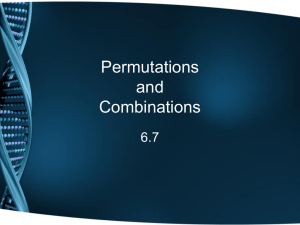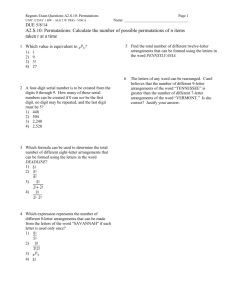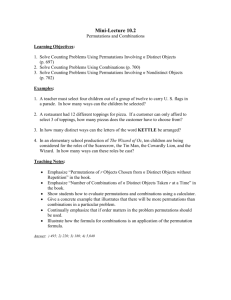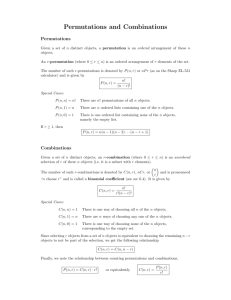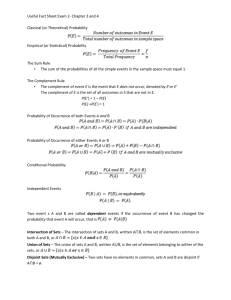“JUST THE MATHS” UNIT NUMBER 19.2 PROBABILITY 2
advertisement
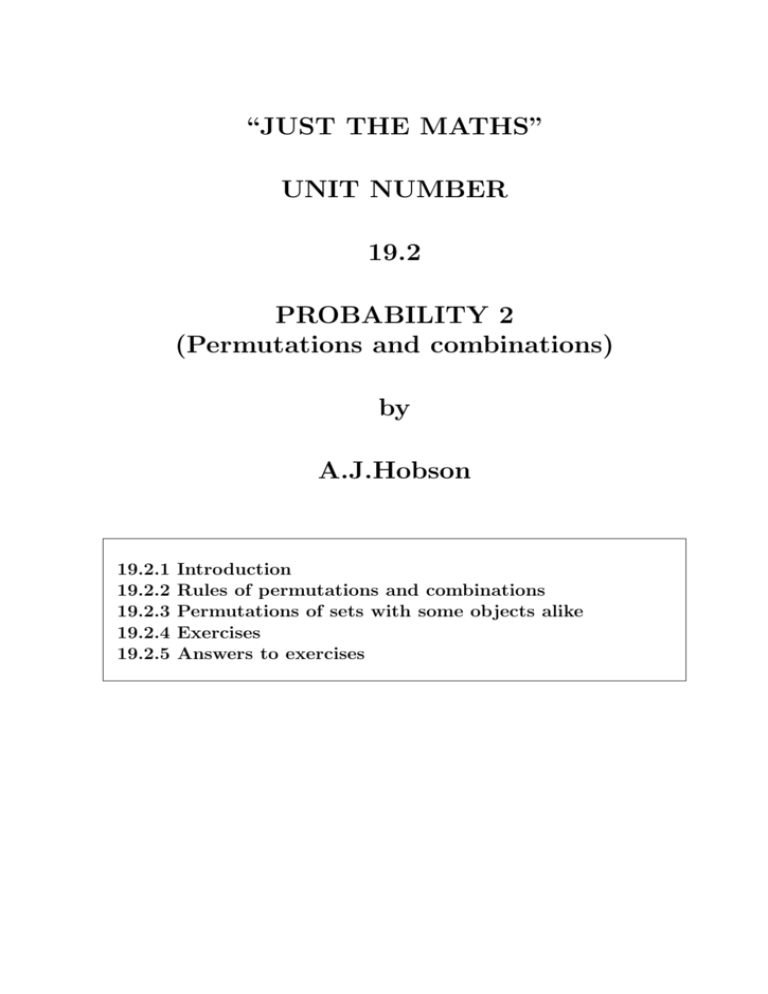
“JUST THE MATHS” UNIT NUMBER 19.2 PROBABILITY 2 (Permutations and combinations) by A.J.Hobson 19.2.1 19.2.2 19.2.3 19.2.4 19.2.5 Introduction Rules of permutations and combinations Permutations of sets with some objects alike Exercises Answers to exercises UNIT 19.2 - PROBABILITY 2 - PERMUTATIONS AND COMBINATIONS 19.2.1 INTRODUCTION In Unit 19.1, we saw that, in the type of problem known as “descriptive”, we can work out the probability that an event will occur by counting up the total number of possible trials and the number of successful ones amongst them. But this can often be a tedious process without the results of the work which is included in the present Unit. DEFINITION 1. Each different arrangement of all or part of a set of objects is called a “permutation”. DEFINITION 2. Any set which can be made by using all or part of a given collection of objects, without regard to order, is called a “combination”. EXAMPLES 1. Nine balls, numbered 1 to 9, are put into a bag, then emptied into a channel which guides them into a line of pockets. What is the probability of obtaining a particular nine digit number ? Solution We require the total number of arrangements of the nine digits and this is evaluated as follows: There are nine ways in which a digit can appear in the first pocket and, for each of these ways, there are then eight choices for the second pocket. Hence, the first two pockets can be filled in 9 × 8 = 72 ways. Continuing in this manner, the total number of arrangements will be 9 × 8 × 7 × 6 × ...... × 3 × 2 × ×1 = 362880 = T, (say). This is the number of permutations of the ten digits and the required probability is therefore equal to T1 . 2. A box contains five components of identical appearance but different qualities. What is the probability of choosing a pair of components from the highest two qualities ? Solution Method 1. Let the components be A, B, C, D, E in order of descending quality. 1 The AB BC CD DE, choices are AC AD AE BD BE CE giving ten choices. These are the various combinations of five objects, two at a time; hence, the probability 1 for AB = 10 . Method 2. We could also use the ideas of conditional probability as follows: The probability of drawing A = 15 . The probability of drawing B without replacing A = 14 . The probability of drawing A and B in either order = 2× 1 1 1 × = . 5 4 10 19.2.2 RULES OF PERMUTATIONS AND COMBINATIONS 1. The number of permutations of all n objects in a set of n is n(n − 1)(n − 2)....................3.2.1 which is denoted for short by the symbol n! It is called “n factorial”. This rule was demonstrated in Example 1 of the previous section. 2. The number of permutations of n objects r at a time is given by n(n − 1)(n − 2)....................(n − r + 1) = n! (n − r)! Explanation The first object can be chosen in any one of n different ways. For each of these, the second object can then be chosen in n − 1 ways. For each of these, the third object can then be chosen in n − 2 ways. ... ... ... For each of these, the r-th object can be chosen in n − (r − 1) = n − r + 1 ways. 2 Note: In Example 2 of the previous section, the number of permutations of five components two at a time is given by 5! 5! 5.4.3.2.1 = = = 20. (5 − 2)! 3! 3.2.1 This is double the number of choices we obtained for any two components out of five because, in a permutation, the order matters. 3. The number of combinations of n objects r at a time is given by n! (n − r)!r! Explanation This is very much the same problem as the number of permutations of n objects r at a time; but, as permutations, a particular set of objects will be counted r! times. In the case of combinations, such a set will be counted only once, which reduces the number of possibilities by a factor of r!. In Example 2 of the previous section, it is precisely the number of combinations of five objects two at a time which is being calculated. That is, 5! 5! 5.4.3.2.1 = = = 10, (5 − 2)!2! 3!2! 3.2.1.2.1 as before. Note: A traditional notation for the number of permutations of n objects r at a time is n Pr . That is, n! n Pr = (n − r)! A traditional notation for the number of combinations of n objects r at a time is n Cr . That is, n! n Cr = (n − r)!r! 3 EXAMPLES 1. How many four digit numbers can be formed from the numbers 1,2,3,4,5,6,7,8,9 if no digit can be repeated ? Solution This is the number of permutations of 9 objects four at a time; that is, 9! = 9.8.7.6. = 3, 024. 5! 2. In how many ways can a team of nine people be selected from twelve ? Solution The required number is 12 C9 = 12! 12.11.10 = = 220. 3!9! 3.2.1 3. In how many ways can we select a group of three men and two women from five men and four women ? Solution The number of ways of selecting three men from five men is 5 C3 = 5.4. 5! = = 10. 2!3! 2.1 For each of these ways, the number of ways of selecting two women from four women is 4 C2 − 4! 4.3 = = 6. 2!2! 2.1 The total number of ways is therefore 10 × 6 = 60. 4. What is the probability that one of four bridge players will obtain a thirteen card suit ? Solution The number of possible suits for each player is N = 52 C13 = 52! 39!13! The probabilty that any one of the four players will obtain a thirteen card suit is thus 4× 1 4.(39!)(13!) = ' 6.29 × 10−10 . N 52! 4 5. A coin is tossed six times. Determine the probablity of obtaining exactly four heads. Solution In a single throw of the coin, the probability of a head (and of a tail) is 12 . Secondly, the probability that a particular four out of six throws will be heads, and the other two tails, will be 1 1 1 1 1 1 1 1 . . . . . = 6 = . 2 2 2 2 2 2 2 64 Finally, the number of choices of four throws from six throws is 6 C4 = 6! = 15. 2!4! Hence, the required probability of exactly four heads is 15 . 64 19.2.3 PERMUTATIONS OF SETS WITH SOME OBJECTS ALIKE INTRODUCTORY EXAMPLE Suppose twelve switch buttons are to be arranged in a row, and there are two red buttons, three yellow and seven green. How many possible distinct patterns can be formed ? Solution If all twelve buttons were of a different colour, there would be 12! possible arrangements. If we now colour two switches red, there will be only half the number of arrangements since every pair of positions previously held by them would have counted 2! times; that is, twice. If we then colour another three switches yellow, the positions previously occupied by them would have counted 3! times; that is, 6 times, so we reduce the number of arrangements further by a factor of 6. Similarly, by colouring another seven switches green, we reduce the number of arrangements further by a factor of 7!. Hence, the final number of arrangements will be 12! = 7920. 2!3!7! This example illustrates another standard rule that, if we have n objects of which r1 are alike of one kind, r2 are alike of another, r3 are alike of another ........and rk are alike of another, then the number of permutations of these n objects is given by n! r1 !r2 !r3 !...rk ! 5 19.2.4 EXERCISES 1. Evaluate the following: (a) 6 P3 ; (b) 6 C3 ; (c) 7 P4 ; (d) 7 C4 . 2. Verify that n Cn−r = n Cr in the following cases: (a) n = 7 and r = 2; (b) n = 10 and r = 3; (c) n = 5 and r = 2. 3. How many four digit numbers can be formed from the digits 1,3,5,7,8,9 if none of the digits appears more than once in each number ? 4. In how many ways can three identical jobs be filled by 12 different people ? 5. From a bag containing 7 black balls and 5 white balls, how many sets of 5 balls, of which 3 are black and two are white, can be drawn ? 6. In how many seating arrangements can 8 people be placed around a table if there are 3 who insist on sitting together ? 7. A commitee of 10 is to be selected from 6 lawyers 8 engineers and 5 doctors. If the committe is to consist of 4 lawyers, 3 engineers and 3 doctors, how many such committees are possible ? 8. An electrical engineer is faced with 8 brown wires and 9 blue wires. If he is to connect 4 brown wires and 3 blue wires to 7 numbered terminals, in how many ways can this be done ? 9. A railway coach has 12 seats facing backwards and 12 seats facing forwards, In how many ways can 10 passengers be seated if 2 refuse to face forwards and 4 refuse to face backwards ? 6 19.2.5 ANSWERS TO EXERCISES 1. (a) 120; (b) 20; (c) 840; (d) 35. 2. (a) 21; (b) 120; (c) 10. 3. 6 P4 = 360. 4. 12 C3 = 220. 5. 7 C3 × 5 C2 = 350. 6. 3! × 8 × 5! = 5760. 7. 6 C4 × 8 C3 × 5 C3 = 8400. 8. 8 C4 × 9 C3 × 7! = 29, 635, 200. 9. 12 P2 × 12 P4 × 18 P4 = 115, 165, 670, 400. 7

